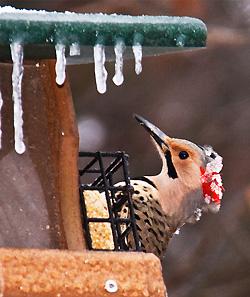Great Backyard Bird Count Sets New Species Record
Nearly half the world’s species identified in four days
New York, NY, Ithaca, NY, and Port Rowan, ON–Participants from more than 100 countries submitted a record 147,265 bird checklists for the annual Great Backyard Bird Count and broke the previous count record for the number of species identified. The 5090 species reported represents nearly half the possible bird species in the world. The four-day count was held February 13-16, the 18th year for the event which is a joint project of the Cornell Lab of Ornithology and the National Audubon Society with partner Bird Studies Canada.
The information gathered by tens of thousands of volunteers helps track the health of bird populations at a scale made possible by using the eBird online checklist program. A sampling of species found by intrepid counters include Ibisbill in India, Bornean Bristlehead in Malaysia, and Magellanic Plover in Chile, complete with amazing photos. GBBC participants even reported two species, Millpo Tapaculo and Santa Marta Screech-Owl, that have not yet been described in the official scientific literature.
Bitter Weather
The bitter cold, snowy weather in much of Canada and the northeastern United States was a major factor in this year’s count. In much of the Northeast, Sunday was particularly frigid and windy, and the number of reports showed an obvious dip as some counters were forced indoors. As one participant in Quebec noted, watching birds came with a price as wind chill temperatures rarely topped -20 degrees Celsius.
For those who did brave the cold, the GBBC data will help to better understand the impact of the cold on birds and bird populations. For example, scientists will be able to compare the abundance of some so-called “half-hardy” species, such as Carolina Wren and Yellow-rumped Warbler, to see if this cold winter has affected their populations.
Snowy Owl Echo
Snowy Owls are one of the most charismatic and emblematic birds of winter. They breed in Arctic regions worldwide and drop south in some winters (“irrupt”), depending on food supplies and their breeding success in the previous summer. The winter of 2013-14 was a huge year for these owls, which appeared in amazing numbers across southern Canada, the Great Lakes states, Northeastern U.S., and the Atlantic Coast. GBBC reports for 2015 also show a surge in Snowy Owl sightings across the same range, though the frequency of reports is about half of last winter’s. This is a well-known phenomenon with Snowy Owls, with the year after a very large invasion often being referred to as an “echo flight.”
Winter Finches
Winter finches—such as Evening Grosbeaks, Pine Siskins, redpolls, and crossbills—are popular among GBBC participants. These birds also “irrupt” south of their usual haunts depending on food supplies, so their numbers in a given region may change widely from year to year.
2015 was a banner year for Pine Siskins which are reported on 10.5% of GBBC checklists so far. Compare that to 1.2% of checklists in 2014 when most siskins stayed far north in Canada. Siskins will likely be hanging around through April and May, especially if the feeders are stocked with their favorite nyjer (thistle) seed.
GBBC Top 10 Lists
Surprisingly, a Eurasian species, the Brambling, appears on the Top 10 list of most reported species for the first time ever. Since November, some of these birds have been spotted on the West Coast and others strayed even farther by turning up in Montana, Wyoming, and Ontario, with one 2015 GBBC record in North America from Washington state. But the Brambling’s appearance among the Top 10 can be traced to one checklist from Germany reporting a flock estimated at one million birds. Up to three million Bramblings have been known to gather at that site.
In North America, California sits atop the leader board with the most checklists submitted and the greatest number of species, followed by Pennsylvania and New York. Ontario, Canada, is in the Top 10 for the second year in a row, nudging past Ohio and Georgia. In Canada, participation is up in Québec this year largely because of a new eBird portal hosted in partnership between Regroupement QuébecOiseaux and Bird Studies Canada. Quebec residents have submitted 1520 checklists, while last year’s total was 1014. British Columbia participants have the highest species total so far, with 197.




